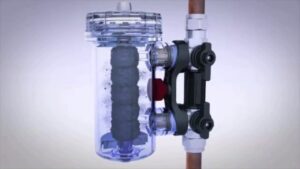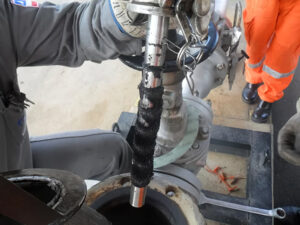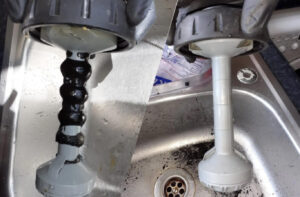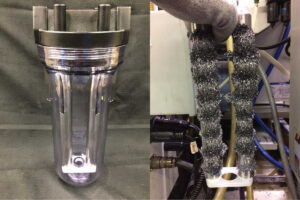A magnetic filter is a specialized device that uses magnetic fields to remove ferrous (magnetic) contaminants from liquids and gases. But how exactly does this purification process work? In this comprehensive guide, as a professional magnetic filter manufacturer, I’ll walk you through the key components and operating principles behind magnetic filtration technology.

What is a Magnetic Filter?
A magnetic filter consists of a housing that contains a powerful magnetic core or array of magnetic rods. As fluid flows through this housing, the magnets produce strong magnetic fields that attract ferrous particles. These particles are captured and held by the magnets while the cleaned fluid exits the filter.
Magnetic filters are used across various industries to protect equipment from wear and contamination. Common applications include hydraulic systems, metalworking fluids, lubrication oil, food manufacturing, and even pharmaceutical production.
How Does a Magnetic Filter Work?
The operating concept behind a magnetic filter is straightforward:
- Create a Magnetic Field
The magnetic rods or core inside the filter produce strong magnetic fields within the filter housing. The strength of this field determines how fine of particles can be captured. The most powerful neodymium magnets in filters can remove particles down below 10 microns. - Fluid Flow Exposure
As fluid moves through the housing, ferrous particles are exposed to the magnetic field. The design of the housing ensures maximum exposure time to enable particle capture. - Particle Attraction
The magnetic field attracts and captures any ferrous particles. Because these particles are magnetic, they are pulled firmly against the magnet or rods where they adhere. - Fluid Purification
The remaining fluid has had all magnetic contaminants removed by the filter. This purified fluid can then be used safely in hydraulic equipment or continue for further processing depending on the application.
Now let’s look closer at the components and options when selecting an industrial magnetic filter.
Key Components of a Magnetic Filter
Filter Housing
This is the main body of the filter where fluid flows through. The housing channels the flow to ensure sufficient exposure to the magnets for particle capture. Housings are made from materials like stainless steel or plastic to match compatibility requirements.
Magnet Type
The magnet is arguably the most critical component. Magnetic filters use either a solid magnetic core or arrays of magnetic rods aligned inside the housing. The material is usually a rare earth neodymium alloy for maximum magnetic field strength.
Magnet Arrangements
Magnets can be oriented in different configurations inside the housing to optimize particle capture. Some options include single rod, double rod, concentric ring, or grate arrangements. Flow rate, viscosity, and contamination levels all factor into the ideal magnet layout.
Filtration Rating
The filtration rating indicates the size of particles the magnets can capture. High-powered industrial magnetic filters can remove ferrous particles below 5 microns (5 thousandths of a millimeter). Compare this to media filters that rely on physical barriers and have larger pores around 40 microns.
Self-Cleaning vs Manual Cleaning Magnetic Filters
Magnetic filters come in two main cleaning options:
Self-Cleaning Filters
These filters have an automated cleaning mechanism that periodically removes then discharges the collected particles into a collection bin. This allows the filter to operate unattended. The cleaning cycle timing can match the rate of particle accumulation.
Manually Cleaned Filters
With manual units, the filter housing must be opened periodically to access the magnets. A non-magnetic scraping tool is used to wipe away the captured debris and particles from the magnet’s surface. The housing is then reassembled to resume filtration. This type of filter requires regular maintenance access.
Both self-cleaning and manual options have pros and cons. Factors like cost, maintenance access, contamination rates, and flow volume all help determine the best match for an application. Reputable magnetic filter manufacturers can provide guidance on technology selection.
Benefits of Magnetic Filtration
Now that you understand the operating principles behind these unique filters, let’s review why magnetic filtration delivers value across industrial processes:
Extremely Fine Filtration – By leveraging magnetic fields instead of filter media, magnetic filters reliably remove ferrous particles below 10 microns without flow restriction. Even large volumes of fluid can be filtered.
Lower Wear and Tear – Removing ferrous contaminants protects downstream equipment like bearings, seals, and precision machining. This directly reduces failures and lowers maintenance costs.
Improved Fluid Performance – Contaminant-free fluids lead to better heat transfer, more efficient hydraulics, and longer fluid life. For lubricants, oxidation life improves almost exponentially when ultrafine particles are removed.
Enhanced Product Purity – Several manufacturing industries rely on magnetic filters to capture stray contaminants and produce higher purity outputs. This includes electronics production, food and beverage, and pharmaceutical manufacturing.
Reusable Technology – Manual cleaned filters allow debris to be easily wiped away from magnets so that particles can be reclaimed and the filter housing reused indefinitely.
Versatile Options – With multiple magnet strengths and configurations available plus customizable housings, magnetic filters can accommodate small and large flow rates for both low and high viscosity fluids.
If you need to protect equipment from particle contamination or require purified manufacturing streams, magnetic filtration likely deserves consideration. As highlighted throughout this guide on “How Does a Magnetic Filter Work?”, these specialized separators deliver unique value across liquid and gas processing.





